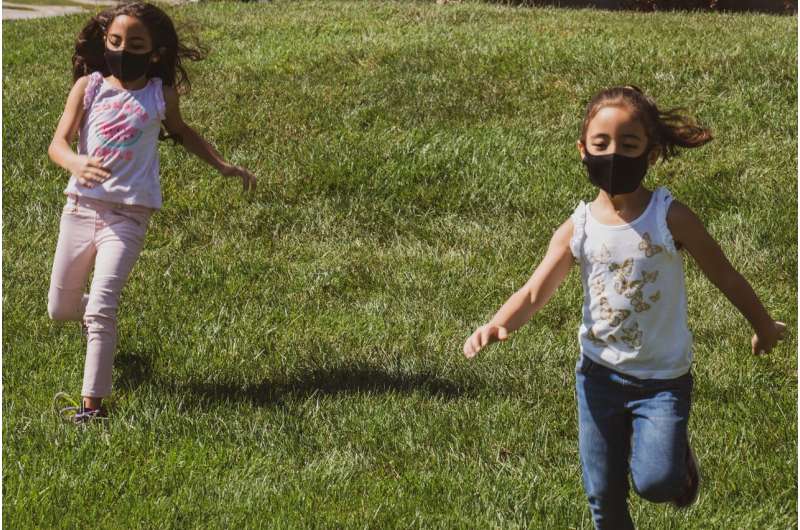Should masks be worn outdoors?

Mask wearing by the public, particularly outdoors, remains controversial. But should masks be worn outside, in some circumstances, to help reduce COVID-19 virus transmission—or should efforts focus on reducing indoor transmission where risks are greater?
Experts debate the issue in The BMJ today.
Babak Javid at the University of California San Francisco and colleagues acknowledge that the risk of COVID-19 virus transmission is far greater indoors than outdoors. Nor do they support policies that mandate masking outdoors when someone is alone or only with members of one household.
But they argue that wearing masks outdoors, particularly at large outdoor gatherings with prolonged close interactions, should be normalised because it may reduce virus transmission and encourage mask wearing indoors, where risks are greater.
They say fears of increased transmission after mass protests in support of the Black Lives Matter movement were not realised, whereas the mass outdoor Sturgis Motorcycle Rally in South Dakota, U.S., is thought to have been the trigger for a huge superspreading-type event.
One proposed reason for these differences is that the Sturgis Rally was associated with lower compliance with measures such as mask wearing and physical distancing that are associated with decreased transmission risk, they explain.
They also point to data from the US and Germany showing that regions with public mask mandates have had a lower impact from the virus, while countries with early adoption of face coverings for the public also achieved an earlier acceptance of a social norm during the pandemic.
In summary, they argue that "wearing masks outdoors, particularly at large outdoor gatherings such as sporting events or other settings where it will be difficult to maintain physical distance for prolonged periods, which may have a low but measurable risk of seeding a superspreading event—as well as normalising mask wearing behaviour in general—will bring benefits in reducing risks during the pandemic phase of COVID-19."
But Dr. Muge Cevik at the University of St Andrews and colleagues argue that outdoor transmission contributes very little to overall infection rates and efforts should focus on reducing indoor transmission.
No confirmed sizeable COVID-19 clusters or "superspreader" events have been outdoors-only, they say. While the Sturgis Rally in South Dakota or the Rose Garden outbreak at the White House are frequently cited as evidence for outdoor-only superspreading events, these events had sustained and multi-day indoor components. For instance, epidemiological investigation of Sturgis Rally found cases linked to restaurants and workplaces.
Given the low risk of transmission outdoors, recommendations or mandates for outdoor masking may seem arbitrary, affecting people's trust and sustained energy to engage in higher yield interventions, such as indoor mask use or staying home if sick, they write.
What's more, an outdoor mask requirement "might serve as a disincentive to be outdoors, which could worsen social isolation."
Equity concerns are also vital, they add, because people who have access to back gardens or can afford private transport to less population dense areas can enjoy the outdoors unmasked, while many others without such privileges or resources cannot enjoy fresh air or exercise unmasked in settings where mask use is universally mandated outdoors.
They believe the public should be informed about the evolving scientific understanding of transmission mechanisms and should be encouraged to be most vigilant in indoor settings, while noting that prolonged and close contact outdoors may pose a risk.
Ultimately, outdoor mask mandates may be popular in some settings, as they are among the most "visible interventions" purporting to demonstrate decisive leadership, they write.
"However, these mandates do little to tackle the real transmission risks or to address outcomes of socioeconomic inequities and structural racism, driving a disproportionate number of the infections and consistent disparities observed worldwide," they conclude.
A linked article asks what do we know about airborne transmission of SARS-CoV-2? The World Health Organization is currently of the opinion that viral transmission by aerosols, while possible for COVID-19, is not the main route by which SARS-CoV-2 spreads.
And in a linked commentary, The BMJ's patient editor explains why she wears a mask indoors and out. "Wearing a mask doesn't mean that you are weak or cowardly. It's a way to protect vulnerable people around you," she writes. "I am vaccinated, yet I wear a mask inside or outside in solidarity with those who are still vulnerable."
More information: Babak Javid et al, Should masks be worn outdoors?, BMJ (2021). DOI: 10.1136/bmj.n1036



















